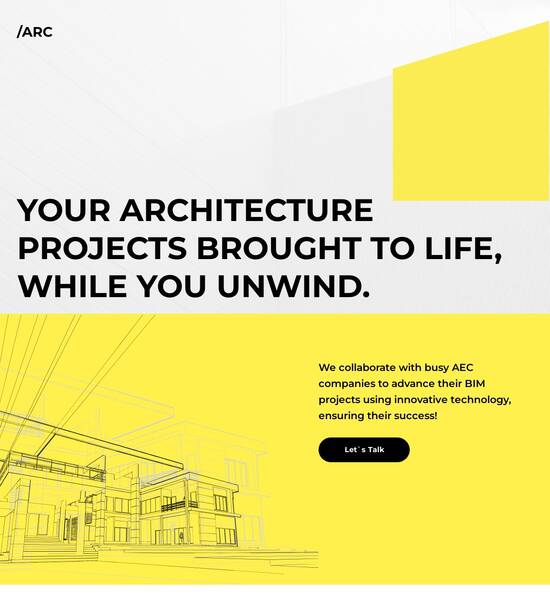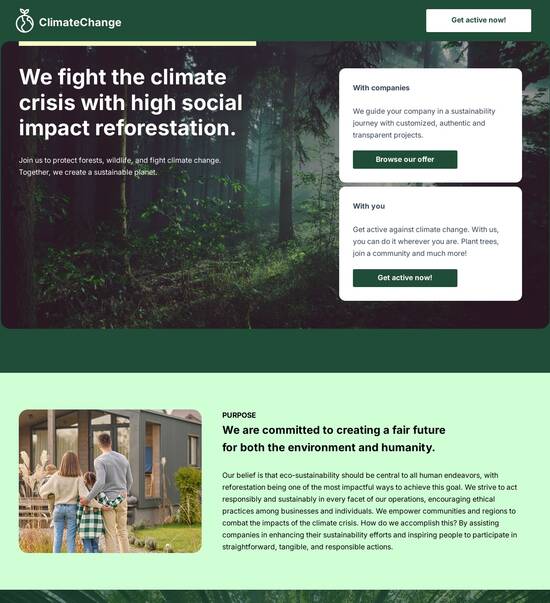
HTML page template with interactive course registration form
Explore Similar TemplatesAbout template
Use HTML page templates with interactive course registration form and make your communications easy and transparent. Try our solution today.
Recommended templates

Easy to build without coding
With the intuitive drag-and-drop builder, anyone on your team can create high-converting pages without any knowledge of code or design. Make enhancements to your landing page with custom widgets using Javascript, HTML/CSS, or third-party scripts.

Multiple layouts for any industry and goal
Select from 500+ landing page layouts built to boost conversions across industry-specific scenarios. Customize them by adjusting fonts, adding images, and generating on-brand content with the AI assistant. Quickly scale with Instablocks® and Global Blocks that you can save, reuse, and update globally.

Loads fast and looks polished on any device
Every template is responsive, which means they present professionally on any device and load blazingly fast with our Thor Render Engine. You can also power them up with Google AMP technology to deliver an unparalleled mobile experience and drive higher conversions.

Robust analytics & experimentation
Get real-time updates and reporting across all your devices, showing the number of visitors, conversions, cost-per-visitor, and cost-per-lead. Launch AI-powered experiments, run A/B tests, and use heatmaps to analyze user behavior, then optimize your landing page to maximize conversions.







Easy to build without coding
With the intuitive drag-and-drop builder, anyone on your team can create high-converting pages without any knowledge of code or design. Make enhancements to your landing page with custom widgets using Javascript, HTML/CSS, or third-party scripts.
Multiple layouts for any industry and goal
Select from 500+ landing page layouts built to boost conversions across industry-specific scenarios. Customize them by adjusting fonts, adding images, and generating on-brand content with the AI assistant. Quickly scale with Instablocks® and Global Blocks that you can save, reuse, and update globally.
Loads fast and looks polished on any device
Every template is responsive, which means they present professionally on any device and load blazingly fast with our Thor Render Engine.
Robust analytics & experimentation
Get real-time updates and reporting across all your devices, showing the number of visitors, conversions, cost-per-visitor, and cost-per-lead. Launch AI-powered experiments, run A/B tests, and use heatmaps to analyze user behavior, then optimize your landing page to maximize conversions.
All the features you need to build lead-generating landing pages
Explore more featuresLearn how to build top-performing landing pages for any goal
FAQs
Leading the way in building high-performing landing pages





Create an HTML page template with an interactive course registration form
Using Instapage's robust capabilities, you can design an engaging HTML page template with an interactive course registration form that transforms the way audiences register for courses. The seamless integration of high-converting templates and powerful optimization tools allows marketers to craft personalized experiences that maximize lead generation and drive engagement effectively.
Understanding the Benefits of an Interactive Course Registration Form
An interactive course registration form serves multiple purposes, streamlining the registration process while providing significant insights into user behavior. Here are several key benefits:
- Enhanced User Experience: Interactive forms engage users, making the registration process intuitive and easy.
- Data Collection: Collect vital information efficiently, allowing for better segmentation and targeted marketing.
- Increased Conversion Rates: Well-designed interactive forms often result in higher completion rates, reducing drop-offs during the registration process.
Step 1: Choose the Right Template
The first step in crafting your HTML page template is selecting a suitable layout from Instapage's vast collection. Focus on templates that highlight course details and emphasize calls to action. Consider these points:
- Clarity: Ensure that the template clearly outlines course information, target audiences, and registration prompts.
- Aesthetic Appeal: Choose designs that are visually appealing to attract potential attendees.
- Mobile Responsiveness: Templates must be optimized for mobile devices to accommodate users accessing from various platforms.
Step 2: Customize Your Interactive Form
With your template in place, it’s time to customize the interactive form elements to fit your course branding. Key considerations include:
- Dynamic Elements: Incorporate interactive fields, such as dropdowns and checkboxes, to facilitate user engagement and simplify input.
- Personalized Messaging: Use dynamic text replacement to tailor your form to specific audience segments.
- Validation: Implement input validation to ensure accurate data submission from users.
Step 3: Optimize and Launch
Once your registration form is customized, optimizing it for better performance is crucial. Here are steps for effective optimization:
- A/B Testing: Experiment with different form designs and content to identify which versions convert best.
- Analytics Tracking: Utilize Instapage's analytics tools to monitor user interaction and conversion metrics.
- Feedback Loop: Gather user feedback post-registration to continually enhance the registration experience.
Now you're equipped with a strategic plan to create an effective HTML page template with an interactive course registration form, tailored uniquely to your audience's needs.
Start crafting your landing pages with Instapage to see improved engagement and registration rates for your courses today!
People also ask about HTML page template with interactive course registration form
Creating an HTML page template with an interactive course registration form
Understanding the significance of HTML page templates in modern web development
HTML page templates play a vital role in modern web development, providing the foundational structure for web pages. A template serves as a pre-designed layout that can be reused across various pages or applications, saving time and ensuring consistency in design. Fundamentally, HTML establishes the skeleton of a webpage, defining elements like headings, paragraphs, and multimedia.
In the context of web design, using HTML templates can significantly streamline the development process, allowing developers to focus on functionality and aesthetics rather than constructing each page from scratch. Templates commonly incorporate CSS for styling and JavaScript for interactive elements, ultimately enhancing the user experience.
Interactive course registration forms are one of the key components that can benefit from well-structured HTML templates. By integrating such forms, educators and course providers can significantly enhance user engagement. These forms simplify the process of registering for courses, making it easier for potential students to sign up.
Enhances user engagement by allowing easy interactions.
Simplifies the registration process, encouraging more sign-ups.
Facilitates the collection of user data for further insights.
Key technologies such as HTML, CSS, and JavaScript work in tandem to create powerful, interactive registration systems. HTML lays out the structure, CSS styles it beautifully, and JavaScript ensures that users can interact with the form dynamically. Moreover, these forms can communicate with back-end systems, enabling data processing and storage.
Exploring the core components of an interactive course registration form
When creating an interactive course registration form, structuring the HTML form correctly is essential. This involves identifying the necessary form elements such as input fields for capturing user information and buttons for submission. Input fields should be designed for various types of data, including text, email, and date inputs, which enhances usability and validation.
Additionally, semantic markup plays a critical role in accessibility. Proper tagging not only aids search engines in understanding content but also allows screen readers to accurately convey information to users with disabilities. Utilizing elements like tags linked to fields improves usability greatly.
Styling with CSS is crucial for making your registration form visually appealing. Effective use of colors, fonts, and spacing can guide users through the registration process smoothly. Implementing responsive design principles ensures that the form looks great on any device, from desktop computers to smartphones, which is increasingly vital in today’s mobile-centric world.
Use intuitive layouts and ample white space for readability.
Ensure proper text size and contrast for accessibility.
Utilize media queries to adjust styles for various devices.
JavaScript comes into play to implement functionality within the form. Techniques such as form validation prevent incorrect or incomplete submissions, guiding users to correct errors before proceeding. Additionally, handling user interactions and providing instant feedback are essential elements that help maintain engagement and encourage successful completion of the form.
Innovating user experience through design enhancements
Creating user-friendly input fields is at the heart of a successful registration form. The use of effective field labels and placeholders contributes to clarity, ensuring that users understand what information is required. Employing specific input types, such as date for birthdate or email for email addresses, not only simplifies user interaction but also aids in more accurate data collection.
Button designs significantly influence user engagement during the registration process. Call-to-action buttons should be prominent, with color and size chosen to stand out. A/B testing different button styles can provide insights into which designs drive the highest conversion rates, allowing for data-informed decisions to enhance interaction.
Incorporating popup login features is another strategy to improve user experience. This can streamline the process of user registration and login, offering both efficiency and convenience. Animation techniques can be utilized to make these popups more engaging, drawing the user's attention without causing annoyance.
Use clear, action-oriented text for buttons.
Test different styles using A/B testing.
Incorporate animations mildly to draw attention.
Building interactive features into the registration process
To further enhance the interactive nature of the registration form, creating dynamic forms using JavaScript can engage users more effectively. Implementing dependent fields where the selection of one field influences the options available in another can help tailor the user experience. For example, if a possible course selection influences available times or locations, users will appreciate the streamlined interface.
Real-time validation feedback is essential in maintaining user engagement. Promptly notifying users of errors or successful inputs fosters a smooth registration flow, decreasing frustration. For instance, showing a green checkmark when a valid email is entered can reassure the user of completion.
Integrating multimedia elements can also enhance the registration process. Embedding video tutorials that explain course offerings can guide potential students, presenting information more engagingly than text alone. Images of instructors or course highlights can also attract visual interest, providing users with a clearer picture of what to expect.
Use JavaScript for interactive features like dependent fields.
Implement real-time validation for better feedback.
Embed tutorials and visuals to enhance understanding.
Linking to additional resources provides users with invaluable information. Adding links to course syllabi or instructor profiles allows for deeper exploration. Making navigation seamless between the registration page and these resources will not only help inform users but may also aid in decision-making.
Transformative benefits of implementing registration forms on websites
Implementing registration forms can significantly streamline user registration processes. By reducing friction points during registration, businesses can reduce drop-off rates considerably. To achieve successful outcomes, customized registration strategies should be designed based on user needs, potentially offering different pathways for new users versus returning users.
Effective data collection and management are achieved through well-structured forms. The type of data collected, such as demographic information or course preferences, can be analyzed using various analytical tools. Understanding this data can inform marketing strategies and uncover areas for improvement in course offerings.
Ultimately, a well-designed registration form fosters better user engagement and retention. Automated follow-up emails can be sent to users who complete their registration, keeping them engaged and informed about upcoming courses. Additionally, leveraging user feedback provides critical information for course improvements, creating a continuous cycle of enhancement.
Implement customized strategies to decrease registration drop-offs.
Analyze collected data for informed marketing decisions.
Employ automated follow-ups to improve user engagement.
Demonstrating the functionality through practical examples
A source code walkthrough provides a practical look at the interplay between HTML, CSS, and JavaScript in creating an interactive course registration form. By examining annotated examples, developers can grasp best practices for organizing source code, ensuring clarity and maintainability. Properly structured code not only assists in understanding but also simplifies future development efforts.
A live demo of an interactive registration form can showcase how these concepts come to life. Users can experience a fully functional form, illustrating unique features like popups for additional information and animations for button clicks. Such demonstrations can effectively communicate how design and function work together seamlessly.
Gathering user testimonials also plays a vital role in showcasing the effectiveness of these interactive forms. Reviewing case studies of different businesses that successfully implemented such forms offers valuable insights into improved enrollment rates and enhanced user satisfaction. Metrics derived from these implementations can provide concrete evidence of the positive impact on business outcomes.
Conduct a source code evaluation for clear organization.
Run live demos to showcase functionality to prospective users.
Gather and analyze testimonials to highlight effectiveness.
Future trends in interactive registration systems
The role of Artificial Intelligence (AI) in form optimization is becoming increasingly important. Machine learning can enhance personalization in user experiences, making forms adapt based on past interactions. As systems learn from user behavior, they can tailor experiences more effectively, which can lead to higher engagement and completion rates.
Integrating third-party services also creates new opportunities for enhancing registration processes. API connections for payment processing can streamline transactions, while compatibility with Customer Relationship Management (CRM) systems can optimize user data management. This synergy enables organizations to monitor user behavior and nurture leads effectively.
In considering the evolution of user interfaces, predictions for registration form designs in the next decade lean towards more interactive elements. Emerging technologies such as voice input and augmented reality are set to enhance the registration experience. From voice-activated forms to immersive AR experiences that provide detailed course overviews, the future looks promising for interactive registrations.
Leverage machine learning for improved personalization.
Explore API integrations for seamless user experiences.
Anticipate enhanced features with emerging technologies.
Conclusion on the impact of interactive course registration forms
In closing, the significance of integrating interactive course registration forms within HTML page templates cannot be understated. These forms enhance the overall user experience, streamline processes, and innovate engagement strategies that are vital for attracting potential students. As organizations embrace these advancements, a greater emphasis on user-centric design will yield better outcomes.
The potential for increasing conversion rates is immense, particularly when considering the technological advancements on the horizon. By remaining adaptable and open to iterative improvements, organizations can set themselves up for success. Ultimately, the focus must remain on creating meaningful interactions that foster long-lasting relationships with users.
Encouraging the implementation of these best practices will pave the way for greater engagement and enhanced user experiences across educational offerings. Keeping an eye on technological trends will ensure that registration processes not only meet but exceed user expectations, establishing a standard of excellence in course registration services.
Ready to skyrocket conversions?
Supercharge your ad campaigns with high-performing landing pages
Get started














